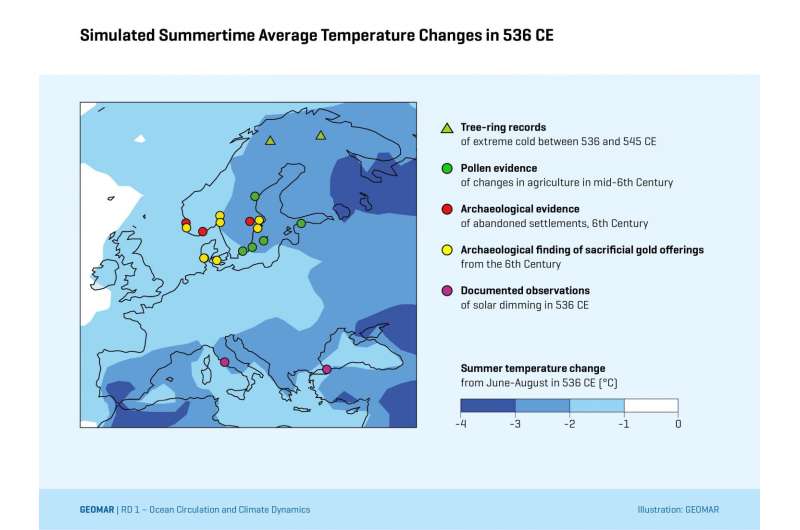Simulated summertime (June-August) average temperature changes in 536 CE due to the stratospheric aerosol cloud resulting from an unknown volcanic eruption reconstructed here based on contemporary written records and ice core sulfate measurements. The simulated temperature changes, ranging from 1-3 ° C over Europe, show good agreement with estimates from two tree-ring temperature reconstructions based on trees in Northern Scandinavia. Credit: Matt Toohey, GEOMAR
Back-to-back volcanic eruptions in the mid-6th century darkened Europe's skies for more than a year and may have ushered in the Dark Ages, according to finding to be presented Friday at a science conference in Vienna.
"Either would have led to significant cooling of Earth's surface," said Matthew Toohey, a climate modeller at the GEOMAR Helmholtz Centre for Ocean Research in Kiel Germany who led the research.
"But taken together, the two eruptions"—in 536 and 540—"were likely the most powerful volcanic event affecting the northern hemisphere climate over at least the past 1,500 years," he told AFP at a meeting of the European Geosciences Union.
Their combined impact lowered temperatures by two degree Celsius (3.6 degrees Fahrenheit) during what is probably the coldest decade in the last two millennia, he added.
This sudden drop, caused by a Sun-blocking blanket of sulphur particles in the stratosphere, had a devastating impact on agriculture, provoking famine throughout much of Europe and beyond.
The continent's first pandemic plague occurred one year after the second blast, though it is not known whether the volcanic winter played a direct role in the disease's spread, Toohey and colleagues reported this week in the journal Climatic Change.
More broadly, the twin blasts marked the pivot between the waning years of Antiquity and the prolonged period of social decline and turmoil known as the Dark Ages.
In an innovative bit of detective work, the study combined climate science, archeology and history, disciplines that do not often overlap.
Many contemporary accounts—including one from the Byzantine historian Procopius, who lived in Rome—described the "mystery cloud" that shrouded the skies in 536.
"The Sun gave forth its light without brightness, like the Moon, during this whole year," he wrote at the time, comparing the impact to an unending eclipse.
Decline of Mayan civilisation
Historical records attest to devastating famine in the ensuing years, and a broader collapse of social structures across much of northern Europe.
Official histories from China also registered strange climate phenomena followed by crop failures and mass starvation.
But not until recently did scientists deliver proof that the global solar dimming was caused by two volcanic eruptions.
The evidence came from Greenland and Antarctica in the form of ice cores, layered time capsules reaching back thousands of years that preserve particles from the atmosphere.
Not only did telltale traces of sulphur pinpoint the dates when the two eruptions occurred, the cores also revealed that the first one happened in the northern hemisphere and the second somewhere in the tropics.
Coincidentally, another team of scientists led by Kees Nooren of Utrecht University in the Netherlands reported at the Vienna conference this week that the El Chichon volcano in southern Mexico blew it's top in 540, contributing to the decline of the Mayan civilisation, then at its apex.
An analysis of ash layers in the Maya lowlands, generated by the eruption, fit perfectly with ice core records, Nooren said.
But all these elements still did not help Toohey reconcile conflicting evidence as to just how big the two eruptions were.
Tree rings suggested that 536 was the single coldest year of at least the last two millennia, and the following decade the coldest over the same period.
The ice cores, however, pointed to somewhat less dramatic eruptions.
So Toohey devised a climate model to test different scenarios, depending on how many millions of tonnes of volcanic ash and debris were jettisoned into the sky, and how high the plumes went.
"In the model, we injected sulphur to different heights, to see which—in terms of long-lasting effect—would be consistent with the historical accounts," he explained.
"That's is how the contemporary observations helped us to determine something the ice cores couldn't tell us."
More information: Matthew Toohey et al. Climatic and societal impacts of a volcanic double event at the dawn of the Middle Ages, Climatic Change (2016). DOI: 10.1007/s10584-016-1648-7
Journal information: Climatic Change
© 2016 AFP
























